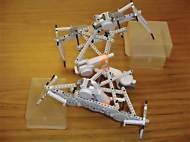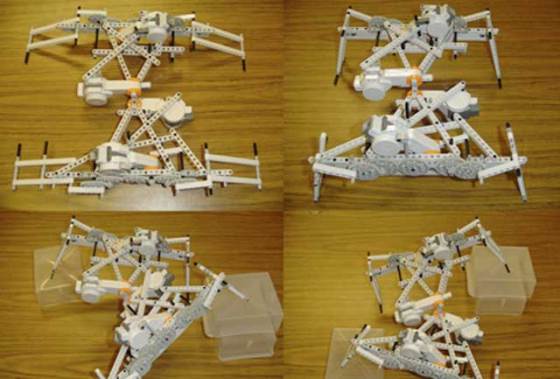Evolutive morphological change of robots enhances their capabilities
 In his experiment, University of Vermont roboticist Josh Bongard created both simulated and actual robots that, just like tadpoles become frogs, change their body forms while learning how to walk. Over iterations in versions (generations), his simulated robots managed to evolve – spending less time in “infant” tadpole-like forms and more time in “adult” four-legged forms.
In his experiment, University of Vermont roboticist Josh Bongard created both simulated and actual robots that, just like tadpoles become frogs, change their body forms while learning how to walk. Over iterations in versions (generations), his simulated robots managed to evolve – spending less time in “infant” tadpole-like forms and more time in “adult” four-legged forms.
These evolving populations of robots were able to learn to walk more rapidly than ones with fixed body forms. In their final form, the changing robots managed to develop a more robust gait — better able to deal with, say, being knocked with a stick — than the ones that had learned to walk using upright legs from the beginning.
“They have lots of moving parts. And their brains, like our brains, have lots of distributed materials: there’s neurons and there’s sensors and motors and they’re all turning on and off in parallel”, Bongard said, “and the emergent behavior from the complex system, which is a robot, is some useful task like clearing up a construction site or laying pavement for a new road.”
Engineers struggle to create robots that can continually perform simple, yet adaptable, behaviors in unstructured or outdoor environments. Rather than trying to program the robots’ behavior directly, Bongard and other robotics experts have turned to computer programs to design robots and develop their behaviors.
By using a sophisticated computer simulation, Bongard unleashed a series of synthetic creatures that move about in a 3D space. Each generation of the creatures go through a software routine (genetic algorithm) that experiments with various motions until it develops a slither, shuffle, or walking gait that can get it to the light source without tipping over.
“The snake and reptilian robots are, in essence, training wheels”, said Bongard, “they allow evolution to find motion patterns quicker, because those kinds of robots can’t fall over. So evolution only has to solve the movement problem, but not the balance problem, initially. Then gradually over time it’s able to tackle the balance problem after already solving the movement problem.”
The key point is that his robots don’t only evolve their artificial brain — the neural network controller — but rather do that in continuous interaction with a changing body plan. The changing robots were faster in getting to the final goal, and they were able to deal with new kinds of challenges that they haven’t faced before.
Bongard thinks it’s because “controllers evolved in ancestral robots with different body plans had to maintain the desired behavior over a wider range of sensor-motor relationships that controllers evolved in robots with fixed body plans.”
“One thing that has been left out all this time is the obvious fact that in nature it’s not that the animal’s body stays fixed and its brain gets better over time,” he says. “In natural evolution animals bodies and brains are evolving together all the time.”
After running 5,000 simulations, in order to demonstrate his research on a physical platform, Bongard built a relatively simple robot out of a couple of Lego Mindstorm kits. As in the simulation, this physical robot is four-legged, but the Lego creature wears a brace on its front and back legs. The brace is used to gradually tilt the robot, while the controller searches for successful movement patterns.
“While the brace is bending the legs, the controller is causing the robot to move around, so it’s able to move its legs, and bend its spine”, said Bongard. “It’s squirming around like a reptile flat on the ground and then it gradually stands up until, at the end of this movement pattern, it’s walking like a coyote.”
For more information, read his paper published in the Proceedings of the National Academy of Sciences named: ”Morphological change in machines accelerates the evolution of robust behavior”.










Leave your response!